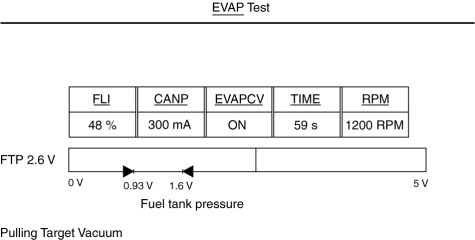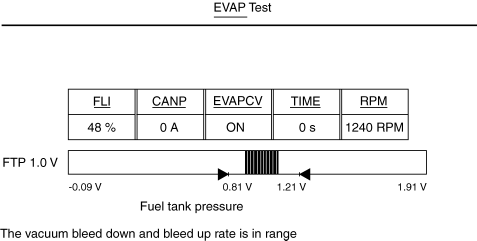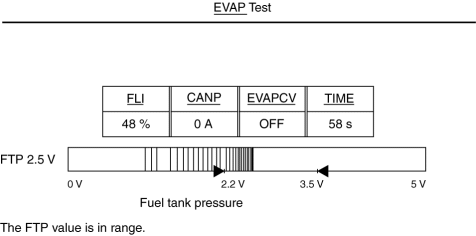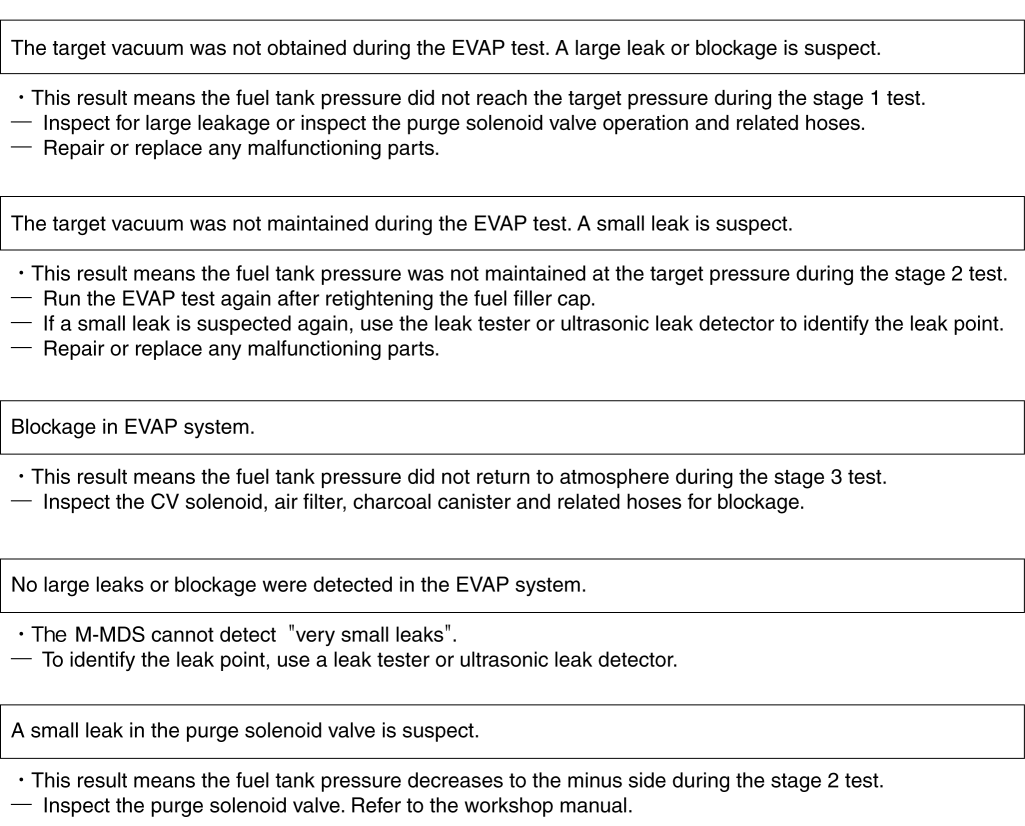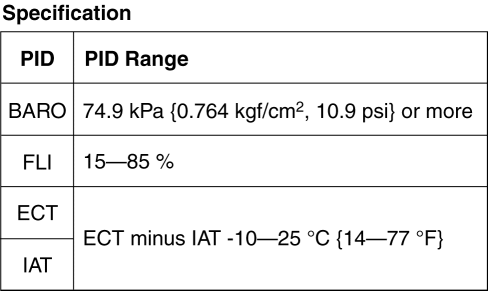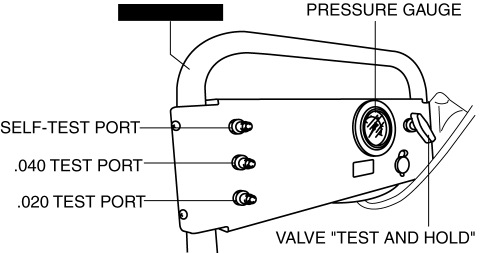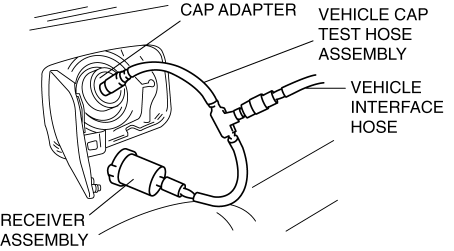|
|
|---|
| STEP | INSPECTION | ACTION |
| 1 | Disconnect the ignition coils from the spark plugs. Remove the spark plugs. (See SPARK PLUG REMOVAL/INSTALLATION [SKYACTIV-G 2.5].) Verify that the spark plugs do not have carbon deposits. Is there any malfunction? | Yes | Perform no-load racing at 4,000 rpm for 2 min, 2 times to burn off the carbon deposits. Repeat this step. |
| No | Go to the next step. |
| 2 | Inspect the spark plugs for damage, wear, and proper plug gap. Is there any malfunction? | Yes | Re-gap or replace the spark plugs, then go to the next step. (See SPARK PLUG REMOVAL/INSTALLATION [SKYACTIV-G 2.5].) |
| No | Go to the next step. |
| 3 | Reconnect the spark plugs to the ignition coil. Ground the spark plugs to the engine. Is a strong blue spark visible at each cylinder while cranking the engine? | Yes | Ignition system is normal. |
| No | Some cylinders do not spark:
All cylinders do not spark:
|
| 4 | Switch the ignition off. Inspect the wiring harness between the following terminals (wiring harness-side) for an open or short circuit:
-
Ignition coil/ion sensor No.1 terminal B—PCM terminal 1AY
-
Ignition coil/ion sensor No.2 terminal B—PCM terminal 1AT
-
Ignition coil/ion sensor No.3 terminal B—PCM terminal 1AO
-
Ignition coil/ion sensor No.4 terminal B—PCM terminal 1AJ
Is there any malfunction? | Yes | Refer to the wiring diagram and verify whether or not there is a common connector between the following terminals:
-
Ignition coil/ion sensor No.1 terminal B—PCM terminal 1AY
-
Ignition coil/ion sensor No.2 terminal B—PCM terminal 1AT
-
Ignition coil/ion sensor No.3 terminal B—PCM terminal 1AO
-
Ignition coil/ion sensor No.4 terminal B—PCM terminal 1AJ
If there is a common connector:
-
Determine the malfunctioning part by inspecting the common connector and the terminal for corrosion, damage, or pin disconnection, and the common wiring harness for an open or short circuit.
-
Repair or replace the malfunctioning part.
|
| No | Inspect the ignition coil. (See IGNITION COIL INSPECTION [SKYACTIV-G 2.5].) Replace the ignition coil/ion sensor. (See IGNITION COIL/ION SENSOR REMOVAL/INSTALLATION [SKYACTIV-G 2.5].) |
| 5 | Switch the ignition off. Disconnect the ignition coil/ion sensor connectors. Switch the ignition ON (engine off). Measure the voltage at each ignition coil/ion sensor terminal A (wiring harness-side). Is the voltage B+? | Yes | Go to the next step. |
| No | Inspect for power supply circuit in wiring harness between ignition switch and ignition coils. Refer to the wiring diagram and verify whether or not there is a common connector between the following terminals:
-
Main relay terminal C—Ignition coil/ion sensor No.1 terminal A
-
Main relay terminal C—Ignition coil/ion sensor No.2 terminal A
-
Main relay terminal C—Ignition coil/ion sensor No.3 terminal A
-
Main relay terminal C—Ignition coil/ion sensor No.4 terminal A
If there is a common connector:
-
Determine the malfunctioning part by inspecting the common connector and the terminal for corrosion, damage, or pin disconnection, and the common wiring harness for a short to power supply.
-
Repair or replace the malfunctioning part.
|
| 6 | Switch the ignition off. Inspect for continuity between terminal D (wiring harness-side) in each ignition coils and body ground. Is there continuity? | Yes | Go to the next step. |
| No | Refer to the wiring diagram and verify whether or not there is a common connector between the following terminals:
-
Ignition coil/ion sensor No.1 terminal D—Body ground
-
Ignition coil/ion sensor No.2 terminal D—Body ground
-
Ignition coil/ion sensor No.3 terminal D—Body ground
-
Ignition coil/ion sensor No.4 terminal D—Body ground
If there is a common connector:
-
Determine the malfunctioning part by inspecting the common connector and the terminal for corrosion, damage, or pin disconnection, and the common wiring harness for an open circuit.
-
Repair or replace the malfunctioning part.
Repeat from Step 1. |
| 7 | Inspect the connection of PCM and ignition coil/ion sensor connectors. Are the PCM connector or ignition coil/ion sensor connectors poorly connected? | Yes | Repair or replace the connector. Repeat from Step 1. |
| No | Go to the next step. |
| 8 | Inspect the CKP sensor and crankshaft pulley. (See CRANKSHAFT POSITION (CKP) SENSOR INSPECTION [SKYACTIV-G 2.5].) Is there any malfunction? | Yes | Repair or replace the malfunctioning part according to the inspection results. (See CRANKSHAFT POSITION (CKP) SENSOR REMOVAL/INSTALLATION [SKYACTIV-G 2.5].) |
| No | Inspect for an open or short circuit in wiring harness and connector of the CKP sensor. Repair or replace the malfunctioning part according to the inspection results. |
